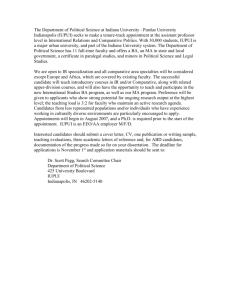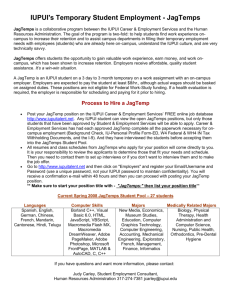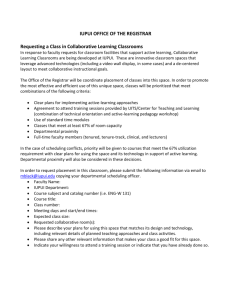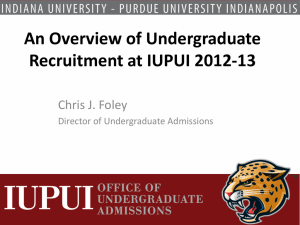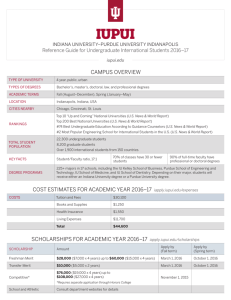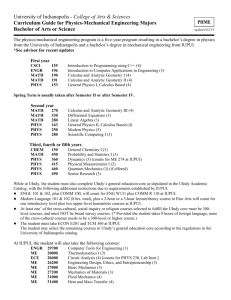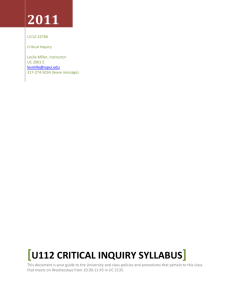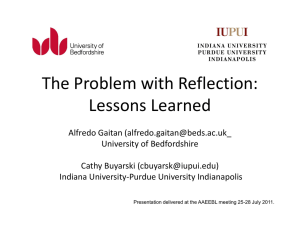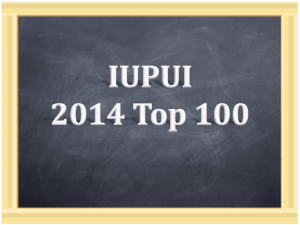Enrollment Trends and Student Success at IUPUI
advertisement
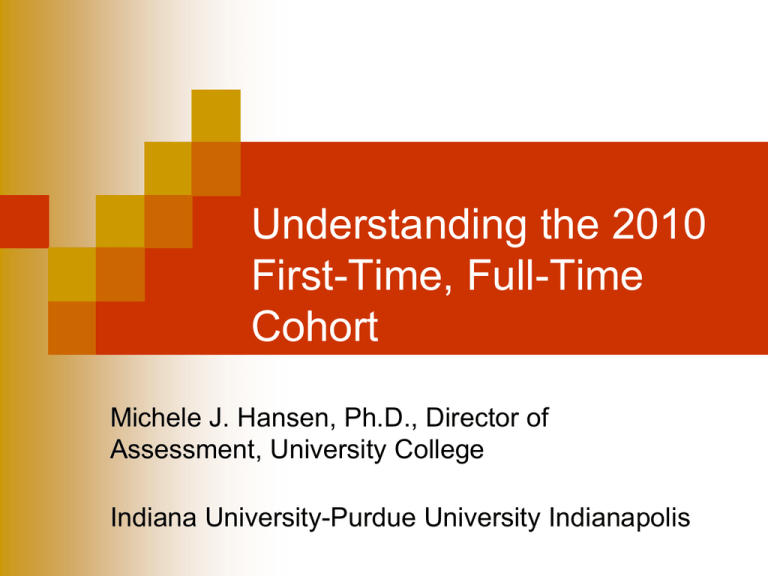
Understanding the 2010 First-Time, Full-Time Cohort Michele J. Hansen, Ph.D., Director of Assessment, University College Indiana University-Purdue University Indianapolis Data Sources Institutional Data ACT-COMPASS Entering Student Survey (= 2191/2606, Response Rate = 84%) 2010 New Student Orientation Entering Student Survey (N =1417/2395, Response Rate estimated = 60%). Students with incorrect or no student id entered were removed from the dataset due to inability to confirm if they officially enrolled and were full-time. Theoretical Framework B = f (P + E + PE) Student Behavior or Success is a function of who students were before they entered college (Person) what happens to them after they enroll (Environment/Interventions) and the interaction of P and E. Student Characteristics, Dispositions, and Attitudes Academic Preparation Knowledge, Skills, and Abilities Student Demographics Socioeconomic Level and Financial Resources Cognitive Motivation (self-efficacy, hope, understanding and commitment to goals) Support Systems Institutional Commitment Intentions External Commitments (family, friends, work) Institutional Factors Academic Support Personal and Social Support Academic and Social Integration Engaging and Challenging Instructional Strategies Early Interventions and Early Warning Systems Financial Support and Scholarships Involvement in Co-curricular Activities Helping Students Build Knowledge, Skills, and Abilities Enhancing Sense of Belongingness and Commitment to IUPUI Helping Students Feel Sense of Purpose, Self-Efficacy, Hope, and and Commitment to Goals Providing Major/Career Exploration and Development Opportunities 2010 Cohort Indianapolis Only 2395 first-time, full-time students 1431 (60%) University College admits 964 (40%) Dual admits/Direct School 190 (8%) admitted conditionally Average SAT score = 890 Average High school GPA = 2.69 First-Generation 47% 1416 (59%) female Only 31 (1%) 25 years of age or older Only 211 (8%) part-time students 94% In-State Students or Resident Students 658 (28%) live in campus housing 967 (40%) First Generation (neither parent attended college or earned a degree beyond a high school diploma) 856 (51%) First-Generation [neither parent completed a 4-year (bachelor’s college degree)] 13.93 Average Course Load 3.25 Average High School GPA 1017 Average SAT score Student Profile Fall 2010 First-Time, Full-Time (IN Only) N Percent White/Caucasian 1776 74.2% Black/African American 256 10.7% Hispanic/Latino 103 4.3% Asian 80 3.3% American Indian/Alaskan Native 1 .0% Native Hawaiian/Pacific 3 .1% Two or More Ethnicities/Races 93 3.9 Non-Resident/International 60 2.5% Refused to Answer/Not Applicable/Missing 23 1% Total 2395 100% IUPUI (IN Only) Percentage of First Generation Students 47 45 First-Generation 46.1 46 45.4 45 44 43.7 43 42 41 40.5 40 40 39 38 37 36 2005 2006 2007 2008 2009 2010 Students’ Finances 2113 (88%) applied for Financial Aid [completed the Free Application for Federal Student Aid (FAFSA) form] 1713 (72%) received Financial Aid. 82% 2009. 1001 (42%) received a Federal Pell Grant. 36% 2009. 76% reported some or major concerns about their ability to finance their college education. 87% plan to work while attending school. 362 (14%) were Eligible to receive the 21st Century Scholarship [251 actually received 21st century Scholarship from the State Student Assistance Commission of Indiana (SSACI)]. Work Commitments Work Hours None 1-10 11-15 16-20 21-31 31+ Total N 233 381 413 500 221 91 1839 % 13% 21% 22% 27% 12% 4% 100% FT, FT 2009 and 2010 Time Commitments (Hours Per Week) 0 5 10 15 5.81 7.11 12.47 12.38 12.90 12.47 Working Off-Campus Relaxing and Socializing Caring for Dependents Commuting to Class Co-Curricular Activities Volunteering 25 18.44 20.03 Studying Working On-Campus 20 3.62 3.45 5.91 7.02 6.09 6.93 4.77 5.3 2009 2010 High Commitment to IUPUI 79% reported that they applied to a college or university other than IUPUI. 65% reported that IUPUI was their first choice (if applied to other universities). 98% reported that it is important for them to graduate from College (agree or strongly agree). 85% reported that it is important for them to graduate from IUPUI (agree or strongly agree). 90% reported that they made the right choice in attending IUPUI (agree or strongly agree). Academic Goal Commitment 79% are certain about their career goals (agree or strongly agree). 76% are certain about their choice of educational program or major (agree or strongly agree). 95% feel confident that they will complete their degrees in a timely manner (agree or strongly agree). 94% plan to earn at least a four-year (bachelor’s degree). Top 11 Reasons 2010 For Selecting IUPUI (rank order by mean importance) 1. 2. 3. 4. 5. 6. 7. 8. 9. 10. 11. Opportunity to receive an Indiana University or Purdue University degree Availability of specific academic programs (majors) Career and job opportunities available in the area after completing my degree Location Cost Ability to work while attending college IUPUI's reputation Opportunities associated with the location of IUPUI in Indianapolis The variety of entertainment and social activities in the downtown area Admissions requirements Opportunity to interact with students from a wide variety of backgrounds 2010 Reasons for Attending College (rank order by mean importance) 1. Acquire knowledge and skills applicable to a specific job or type of work 2. Fulfill a lifelong goal 3. Gain a general education 4. Make more money 5. Get a better job 6. Prepare for graduate or professional school 7. Meet new people 8. My parents wanted me to go 9. Change in financial situation 10. Advance in my current job 11. Issues related to children or childcare 12. Change in marital status High Impact Practices “When I am asked, what one thing we can do to enhance student engagement and increase student success? I now have an answer: make it possible for every student to participate in at least two high impact activities during his or her undergraduate program, one in the first year, and one taken later in relation to the major field. The obvious choices for incoming students are firstyear seminars, learning communities, and service learning” (George Kuh, 2008) Early Interventions 2343 (92%) students enrolled in at least 7 credit hours participated in First-Year Seminars 697 (29%) participated in a Themed Learning Community 421 (18%) participated in the Summer Bridge Program (18 or 10% conditional admits). 210 (9%) participated in the Summer Success Academy Effective Programs and Interventions Summer Success Academy Summer Bridge Themed Learning Communities Summer Bridge – Themed Learning Communities Learning Communities (e.g., Math Linked) First-Year Seminars Academic Advising and Career Development Student Support Services Student African American Brotherhood and Sisterhood (SAAB and SAAS) Personal Development Plans (PDPs) Risk Factors for IUPUI Students – Associated with Low Levels of Academic Achievement and Persistence Gender (Males). Being a First-Generation college student. Amount of time spent working off-campus for pay (over 20 hours per week). Institutional commitment (Intent to Transfer). Low levels of academic preparation (High school GPA is a strong predictor). Living off-campus. Not earning satisfactory academic performance in first-semester (earning below a 2.0). Reporting that she/he was not careful in completing high school assignments and did not complete the assignments on time. Not participating in early interventions or academic support programs. Offered a Pell Grant (proxy for low SES). Summary of Major Changes Expected Accountability and Outcomes Focus: degree completion, on-time graduation, value-added experiences, learning outcomes. More academically prepared students. More International and Out-of-State students. More students entering just out of high school: 18-19 years of age. More students living on-campus. More students working on-campus. Possibly more students attending classes in summer. Improved retention and graduation rates. Improvements in retention and degrees conferred rates may only be attained by moving students through the system more effectively and more efficiently (e.g., providing the support students need to succeed).
